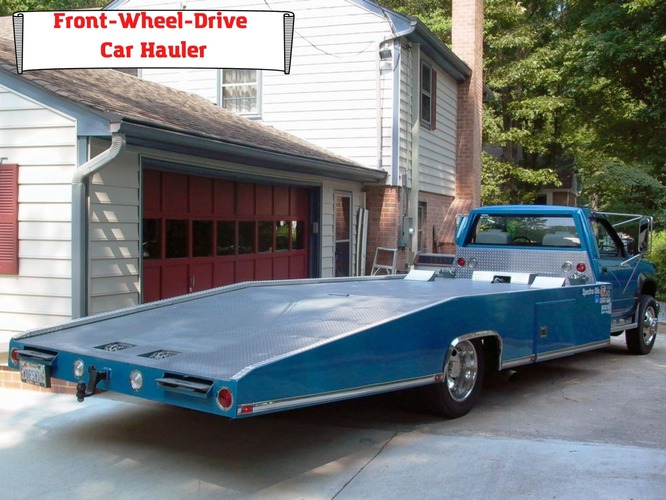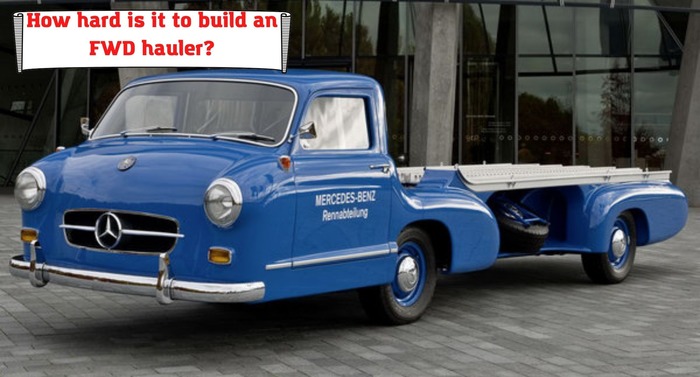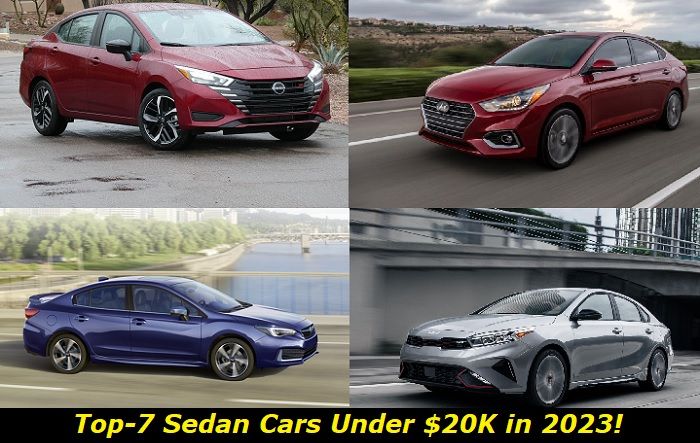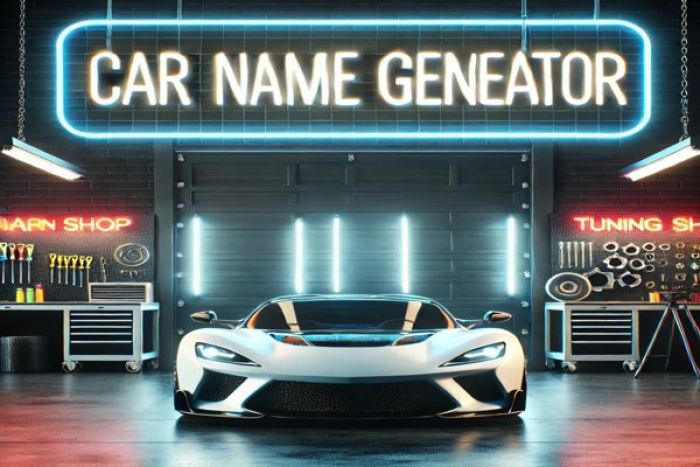
If you operate a garage or constantly haul racing cars to the racing tracks, you might need a cheaper option to haul or move a project car or a race car from one place to another. Front-Wheel-Drive (FWD) cars have good gas mileage and are cheaper to maintain. So, if that is the case, can one haul a heavy-duty trailer or hauler with an FWD drivetrain? And if it is possible to haul loads or trailers with an FWD, how hard is it to build and register an FWD car hauler?
To decide whether you will want to custom-build an FWD car hauler, you need to understand how an FWD vehicle works.
What is an FWD car?
In an FWD car, the engine directs power to the front wheels. It simply means the front wheels in an FWD vehicle pull the car. The rear wheels do not receive any power to pull the vehicle independently. The FWD drivetrain mechanics is less complex since it is easy to connect the power from the engine to the front wheel. Thus, FWD is cheaper compared to other drive trains. FWD cars have better gas mileage compared to AWD and 4WD because they are lighter. They have good traction because the front wheels support the weight of the transmission and the engine. Traction affects the quality of your drive. A good traction functionality makes your drive safer, especially in slippery terrains or when hauling or towing heavy loads. FWDs are also easy to maintain.
However, FWD has poor handling performance compared to AWD and 4WD. For the most part, we haul heavy loads or cars using heavy-duty trucks or AWD vehicles equipped with a heavy-duty towing capacity and better handling performance. AWD cars have greater traction.
Sometimes FWD cars present uneven power application to the front wheels. Other times, it can be challenging to navigate FWD cars around sharp corners and curves. Handling issues may shorten the lifespan of your front wheels. Moreover, the front wheels handle all the steering forces, weight, braking, and acceleration. Note that FWD can also feature an all-wheel-drive feature. In such situations, all four wheels may access power.
Can you haul a trail or car hauler with an FWD drivetrain?
Yes, you can. People around the world have been using FWD car haulers to haul cars. However, you need to know the challenges you may face if you are new to hauling. Some of these challenges include the following.
Visibility issues
The size of the bed and load you are hauling may limit your visibility. Visibility affects how you maneuver on the road and how you perceive the approaching traffic from the rear or the side. Fit your car with towing mirrors to increase your visibility.
Handling corners and curves
When hauling a heavy load, it may affect your ability to handle corners and curves. If the hauling equipment has a wider wheelbase than your car, you will have to make wider turns. Remember, taking turns carelessly or too fast may damage your hauling equipment.
Accelerating
Consider the mass you are hauling before accelerating. The energy you use to accelerate your car will vary depending on the mass you are hauling. The heavy mass tends to resist change, meaning your car will have to work harder to accelerate or change speed. Using the same amount of energy, you would use on a normal basis or when you are not hauling any object may slow the acceleration process.
Braking
Hauling or towing increases the momentum and inertia of your car. This means the brakes on your vehicles may have to work harder when hauling. Consider equipping your hauler with a trailer's braking system. The trailer’s braking system will complement the braking system on your vehicle. Gradually slow down. Use gradual pressure as you brake to avoid skidding or jackknifing. Too much pressure may wear down your brakes.
Load balancing
You may have to rebalance your load constantly as you drive. An unbalanced load may increase the likelihood of your trailer swaying. A swaying trailer may result in a rollover. Moreover, getting a swaying trailer in control is hard.
Remember, even the most basic maneuvers become challenging when you're hauling any object.
Keep in mind that it is more difficult to haul heavy loads using an FWD car hauler. FWDs drivetrain is small, lighter and most of its transmission power is on the front wheels. Hauling trailers or hauling equipment that are heavy and bigger than your car can cause maneuvering issues.
How hard is it to build an FWD hauler?

With the right construction materials at hand, you can easily build a car hauler with an FWD drivetrain.
When custom building an FWD car hauler, it is recommended to go for an FWD powered by large engines, preferably V8 engines.
Trailer’s frame
Go for an open truck bed to reduce the weight of the hauler. Use lighter and more durable material for the bed. You would want to maximize the hauler's towing capacity. Moreover, open bed haulers are lighter, easy, and cheaper to build. Open low bed hauler is also great if you plan on constantly loading and unloading cars on the bed. Ensure the bed is more than 12 feet. A good truck bed should be 12 to 18 feet long.
Axles
Also, think about the type of axles you can access and how they cushion the bed and load carried on the bed. Most small-sized car haulers use a single axle. Single axles are best suited for haulers hauling low-weight loads and hauling loads over short distances. They offer better fuel economy because of their smaller size, provide better adjustable towing angle, and have better maneuverability. However, if you intend to haul heavy loads for long distances, a tandem axle would be the best option.
Look for a reputable trailer-axle dealer when buying an axle. The price varies depending on the towing capacity. If you are looking for cheaper axles with a great towing capacity, mobile home axles can be a good option. A standard mobile home axle has a towing capacity of 6000 pounds. Remember, most manufacturers design mobile home axles for one-time use only. Finding replacement parts can be an unnerving experience.
Trailer’s braking system
Haulers need a good braking system. Consider adding a trailer brake on your hauling equipment. Trailer brakes relieve some pressure from your vehicle's braking system. Trying to stop the hauler with the driver’s braking system alone causes unnecessary stress and pressure on the car’s brakes and hitch.
Be careful when choosing a trailer braking kit. Explore all the options available and settle on a kit that fully meets your needs. Ensure the brake kit is well suited for the trailer axles and the trailer or rather truck bed you choose. You can opt for an electric or surge brake.
Electric brakes use electrical connectors to connect the trailer's brakes to the car's braking system. You can operate the electric brakes using the car's braking pedal or the inertia switch. This means the trailer brakes will activate when you activate the car’s braking system.
Surge brakes use a hydraulic system to connect the trailer's brakes to the car's braking system. It does not require an electric connector. You can operate the surge brakes using the inertia switch. When you slow down, the surge brakes activate keeping the motion of your car and trailer in check. Before going for surge brakes, consider whether it is legal to use such brakes to haul cars or heavy loads in your location. Their legality varies from state to state.
How do you need to register an FWD car hauler?
Most states require you to register a car hauler within 30 days of purchasing the hauler. If your FWD car hauler is a home built, the process may be more involving compared to a commercially built FWD car hauler. The process varies from state to state. All in all, you may need to:
- Put together all the receipts for the materials used to build the FWD car hauler.
- Take the FWD car hauler to the nearest inspection center for a VIN. If the vehicle housing the trailer is registered, use it to tow the trailer to the inspection center.
- The next step is getting a safety certificate for your hauler. The VIN inspection center can also conduct an inspection to assess whether all the components on the hauler work. The inspection center will check whether your hauler has functional brake lights, a trailer or separate braking system, the weight of the hauler, load capacity, and the weight limit you have set for the hauler.
- In some countries, you may have to go to a vehicle registry to get a background check validation.
- The last step is applying for the title of ownership at your vehicle registry. Take all the receipts and requests for title application and an affidavit confirming the ownership of the hauler.
Summary
An FWD car hauler will save you the cost of hiring haulers to haul your car from one place to another. Build your car hauler with precision, and use high-quality materials suited to support heavy loads.
About the authors
The CarAraC research team is composed of seasoned auto mechanics and automotive industry professionals, including individuals with advanced degrees and certifications in their field. Our team members boast prestigious credentials, reflecting their extensive knowledge and skills. These qualifications include: IMI: Institute of the Motor Industry, ASE-Certified Master Automobile Technicians; Coventry University, Graduate of MA in Automotive Journalism; Politecnico di Torino, Italy, MS Automotive Engineering; Ss. Cyril and Methodius University in Skopje, Mechanical University in Skopje; TOC Automotive College; DHA Suffa University, Department of Mechanical Engineering






Add comment